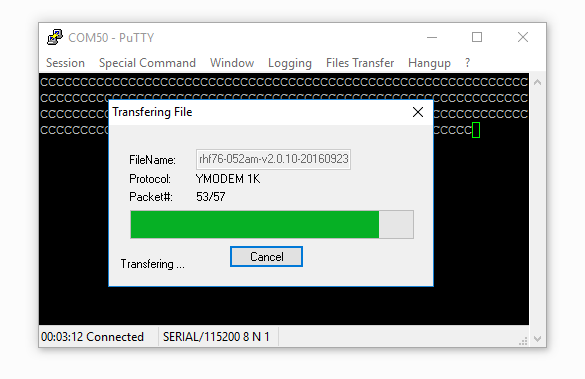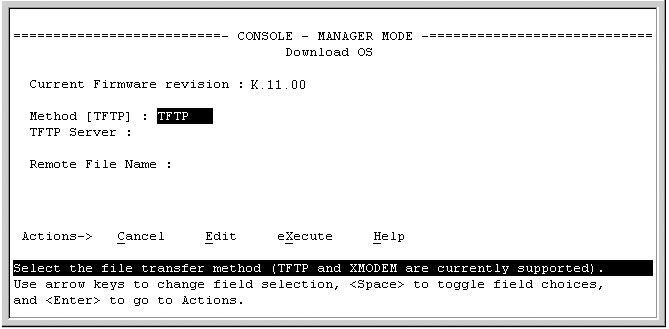Copy xmodem: flash:c2960-lanbasek9-mz.150-2.SE4.bin substituting the filename for your IOS Image, and then under the menues for your Terminal Emulator select 'Send File' or something similar and select your IOS Image and Xmodem-1K (?) as the mode if asked. PuTTY does not support XModem Transfers as best I can tell. I downloaded putty & couldn't see any file transfer method in the options. But I do see file transfer options in Teraterm, but many: kermit, X,Y & ZMODEM, Quick Van and B-Plus. Now, I don't know about any of the protocol mentioned above. PSCP means “PuTTy Secure Copy Protocol (PSCP)”, is a tool for transferring files securely between computers using an SSH connection. To use this utility, we should be comfortable working in the Windows Command Prompt. Now, let’s start to transfer files to Linux: Open Windows Command Prompt. Type pscp sourcepath username@host:targetpath.
Last week at work now, so been rushing to get things sorted out. I have still been doing a bit of study and planing some more ROUTE posts, but with a broken down car and house sale looking like its falling through haven’t had time to do any actually real posting.


Ford 3000 tractor serial numbers. However I came across something today, that I have known about for a while but never really used much. One of the things every one seems to love about CISCO is the fact you can simple copy and past configurations in to the terminal emulator window. And this is indeed great. set up one interface, copy the config to notepad, update it as you wish and past it back in… A real time saver and why we all love CISCO more than Microsoft ;).
In the past this is also how I have always copied backed up configurations on to a new switch/router. Simply open the saved config in notepad. Ctrl-A to select it all, copy and paste to the device. However I was doing this today and hit an issues. With really large configuration files (500+ lines of configuration), I was watching the console windows and could see it was skipping some of the configuration when doing this connected through the serial port. I could see that while things like VLAN’s where being created and the device was pausing, the following lines would some times get lost or corrupted. Now while if you only have a small size configuration file this is not an issue as it is quite easy to check, hundreds of lines become very hard to validate.
I found the best way around this problem was to set up the device with an IP address, put it on a limited access network that has a TFTP sever and copy over the configuration file, either to the startup-config or running-config. This works fine but it is a bit of a hassle going to all that trouble and it means you have to connect the switch to the network, so you have to be very careful with things like VTP and spanning tree. What I really wanted was a way to send the configuration file through the console port.
This made me think of how to recover a corrupted IOS image (which you can fine in the tips and tricks link above). Where boot the device in to ROMmon mode, and then copy the IOS over using the xmodem protocol. Almost all the mainstream terminual emulators have this built in, and while for recovering the IOS you need to increase the baud speed of the console port to speed up the copying process, as the configuration file is only 20-30kb max for most people, the standard speed will move that across in a few seconds.
So then it is just a case of knowing the command to achieve the goal, and I was happy to see it is as simple as it should be. On the device simple type the following from the enable prompt.
router#copy xmodem: startup-config
That’s it, no file names or anything, the device will now wait to receive the file(if you do not start the transfer within a few minutes the device will time out waiting). Then in your terminal emulation program start the transfer. In teraterm it is under the file menu, while secure CRT has a whole menu structure dedicated to various methods to transfer files. Simple chose the xmodem protocol (I found selecting the 1K option was more reliable), and browse to the configuration file, and away it goes. A few moments later the configuration will be on the device (#show Flash: to confirm), and a reboot will have it all up and running.
To me this is a far more reliable way of copying large configurations across, and allows you to easily set up the device from any client, this can be very useful if you are out on site and don’t have access to a limited access network, or the TFTP server to use to copy the files via TFTP or FTP using the network.
DevilWAH.
Putty Xmodem File Transfer Software
PS. Some older routers don’t seem to like you copying from xmodem to nvram, or require you to give a source file name. But you can still achieve the same by copying the file to Flash: .
PPS. Although I prefer the xmodem method, you can improve the reliability of the copy/paste method by increasing the line/character delay in you terminal emulation program. A 5msec delay per character seems to help, although with a 1000+ lines of configuration you may get from a complex configuration, you may find the paste takes a little time, and you may still get errors. Adobe after effects cs6 keygen free download.
How to install the PuTTy Secure Copy client and use it to transfer files
PuTTY is the CIT-recommended application for secure file transfer using SCP between Windows clients and Windows or Unix servers. Its secure copy utility is called PuTTy Secure Copy Protocol (PSCP).
PSCP and PuTTY are available from PuTTY.org.
Install PuTTY SCP (PSCP)
PSCP is a tool for transferring files securely between computers using an SSH connection. To use this utility, you should be comfortable working in the Windows Command Prompt.

- Download the PSCP utility from PuTTy.org by clicking the file name link and saving it to your computer. (If you also want to use the PuTTY shell program, you can download and save putty.exe to your computer as well.)
- The PuTTY SCP (PSCP) client does not require installation in Windows, but runs directly from a Command Prompt window. Move the client program file to a convenient location in your Programs folders and make a note of the location.
To open a Command Prompt window, from the Start menu, click Run.
Cisco Xmodem Ios Transfer
cmd. Click the Command Prompt search result item that appears.- A Command Prompt window will open. To be sure the utility launches correctly from any directory in the Command Prompt window, set up an environment path so your system knows where to look for it. You'll use the pscp.exe location that you made note of in Step 2. For example, if you've saved the pscp.exe file to the folder 'C:Program FilesPuTTy', set up a path by entering
set PATH='%PATH%;%ProgramFiles%putty'at the prompt in the Command Prompt window. - Entering the path in this way only lasts for the duration of the current session (that is, while you have the Command Prompt window open). To set up an environment variable path permanently, open the System control panel in Windows and click Advanced system settings, then click Environment Variables. In the Environment Variables window, select Path from the list of User variables, then click Edit. (If no Path variable is listed, click New.)
- In the Edit User Variable window, click New. Type or paste the directory path for the PSCP utility you noted in Step 2 (for example,
C:/Program Files/putty) into the empty highlighted new line item. - Click OK to save the new entry, then click OK again to close the Environment Variables window. The PSCP program file location is set up in your system and will not need to be entered each time you open a Command Prompt window.

Transfer files using PSCP
Putty Xmodem File Transfer App
Open the Command Prompt Autotask outlook add ins. window, and if necessary set up your path variable as shown above in Step 4.
To copy the local file c:documentsinfo.txt as user username to the server server.example.com with destination directory /tmp/foo, type at the prompt:
pscp c:documentsinfo.txt userid@server.example.com:/tmp/foo/info.txtWhen prompted, enter your password for the server.